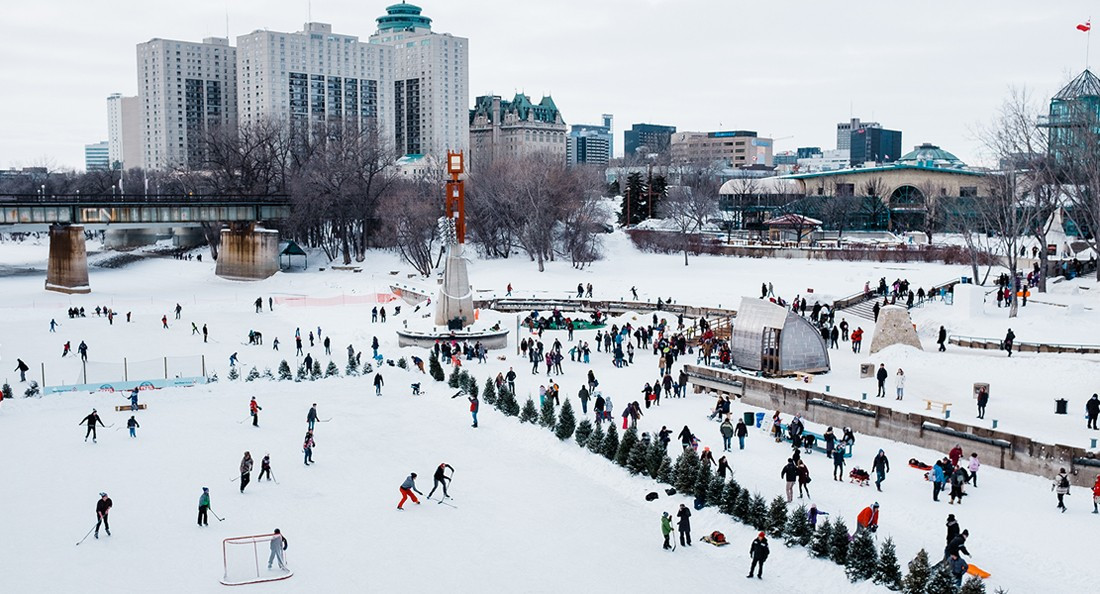Trade and leisure at The Forks
Past meets present at the historical site
The Forks has a history stretching back thousands of years, according to the book The Forks, A Meeting Place Transformed by Sheila Grover and Greg Thomas.
It is named because of where it sits in the City of Winnipeg - where the Red and Assiniboine Rivers meet. The land has been used for trade, communication and transport for over 6,000 years. The Forks is situated on Treaty One land, named for the treaty signed in 1871 between leaders of the Ojibway and Cree nations and the Crown.
Jenny Coombs, a Manitoban and a frequent visitor to The Forks, says she never realized the location had such a long history.
“I always thought that it was just the market where people came to hang out or skate in the winter. I didn’t realize that this is ancestral land or even Treaty One territory,” Coombs says.
Chelsea Thomson, the manager of marketing and communications for The Forks North Portage Partnership, says The Forks has always been a meeting place.
“We say (this) all the time, because it’s true that we’ve been a meeting place for 6,000 years, because that’s how Winnipeg started. People met at the juncture of the two rivers,” Thomson says.
There are many other things that bring visitors to The Forks, like after-work drinks or skating on a Guinness World Record-winning river trail in the winter.
“Because of this (trail), The Forks has been able to bring more people out to the area and has been able to connect more communities together along the trail than before,” Thomson says.
“Some of my friends work near this area, and if we want something different, we’ll come to The Commons and grab a flight of beer and hang out. There’s always lots of people here, and the nature of the space makes you want to chat to your neighbours at other tables. It’s really bringing people together in a very different way,” Coombs says.
The Forks also reinforces its reputation as a meeting place by hosting a wide range of public events year-round, like the Winnipeg International Children’s Festival, also known as Kidsfest, Canada Day, The New Year’s celebration, the 50th Canada Games and many other large events.
According to Thomson, The Forks is host to almost 300 events per year, and more than 90 per cent are third-party events (where The Forks acts as the venue).
Coombs says she has attended a lot of events at The Forks, like Interstellar Rodeo, events related to Pride and other concerts throughout the years.
“I love coming to see events in all parts of The Forks but especially at the Oodena Circle. It’s a beautiful space, and it lets me see and try to understand a culture that is very different from my own,” Coombs says.
The Oodena Celebration Circle is an area to pay homage to the fact that The Forks has been home to Indigenous people for 6,000 years.
Part of the name of the circle, “Oodena” means “heart of the community” in Ojibway and ties back to the Indigenous roots of the area. It features sculptures, a sundial, a ceremonial fire pit and interpretive signage, and it is a naked-eye observatory.
During certain times of the year, like the winter and summer solstices, when a visitor stands at the base of the circle and looks up, the holes of the structure within the Oodena Celebration Circle align with constellations.
Many events, like powwows and Indigenous storytelling, are held within and around the Oodena Circle.
As the area around The Forks is surrounded by water, they have to consider the impact of flooding.
The introduction of the floodway to Winnipeg has helped to protect The Forks and surrounding areas, Thomson says.
“I’ve always wondered if there is a fear of The Forks area flooding, but I’ve only ever seen the water rise up the stairs and the river walk be closed, so I’ve also always assumed it is safe during the spring thaw,” Coombs says.
Another issue The Forks area deals with is that the Red River is often a focal point in news stories.
Coombs says she’s not scared to be around the area, but she’s aware of how the Red River has been seen as an unsafe area.
“I’m comfortable being in the area, because I know that there are organizations and people who are trying to keep the area safe. I hate that there is a negative idea that comes with this beautiful area,” Coombs says.
Volunteer organizations like Drag the Red, which formed in 2014, have emerged to aid in the search for missing persons, like Missing and Murdered Indigenous Women and Girls (MMIWG) in and on the banks of the Red River.
Another connection to MMIWG was when, in 2016, many of Winnipeg’s bridges could be seen adorned by red ribbons, including the Provencher bridge, which runs over the Red River.
Althea Guiboche, also known as the Bannock Lady in Winnipeg, brought the Red Ribbon Campaign - an awareness campaign for MMIWG - to Winnipeg from the Opaskweyak Cree Nation (OCN) after receiving permission from Rhonda Head, one of the founding members of the project.
“The ribbons are meant to be a gentle reminder about this issue. It is to honour our lost loved ones. It is meant to honour the families who are left behind and suffer this loss,” Guiboche says. “Bridges with water were targeted, but any bridge can suffice. It’s meant to connect the women back to the water, as we are the life carriers and the protectors of the water.”
Published in Volume 72, Number 24 of The Uniter (April 5, 2018)







